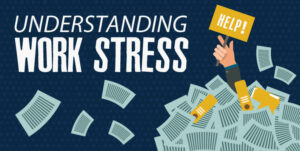Work-related stress can often feel like an unavoidable part of modern life. The demands of our jobs, combined with the pressures of daily life, can leave us feeling overwhelmed and mentally exhausted. However, there is a powerful tool available to combat work stress and improve overall well-being: Cognitive Behavioral Therapy (CBT). In this comprehensive guide, we will explore the principles of CBT for work stress, its techniques, and how it can be applied to improve well-being in the workplace.
Contents
- 1 Understanding Cognitive Behavioral Therapy (CBT)
- 2 The Role of CBT in Managing Work Stress
- 3 The Process of CBT for Work Stress
- 4 How to Access CBT for Work Stress?
- 5 Overcoming Common Misconceptions
- 6 Tips for Incorporating CBT into Your Work Routine
- 7 The Importance of Self-Care Alongside CBT
- 8 Conclusion
Understanding Cognitive Behavioral Therapy (CBT)

CBT is a well-established and highly effective therapeutic approach that focuses on changing negative thought patterns and behaviors. It operates on the principle that our thoughts and perceptions influence our emotions and actions. By identifying and altering dysfunctional thought patterns, CBT empowers individuals to better manage stress, anxiety, and other psychological issues.
CBT is rooted in the idea that our perceptions are not objective truths but interpretations of reality. By challenging and reshaping these interpretations, individuals can gain a more balanced and adaptive perspective.
The Role of CBT in Managing Work Stress
CBT has gained recognition as a valuable tool for managing work-related stress. Its structured and goal-oriented approach equips individuals with the skills to navigate workplace challenges effectively. CBT can help individuals break the cycle of negative thinking, reduce anxiety, and enhance their coping strategies.
Moreover, CBT is highly adaptable to various stressors encountered in the workplace, making it a versatile solution for individuals in diverse professional settings.
The Process of CBT for Work Stress
Cognitive Behavioral Therapy (CBT) is a structured, evidence-based approach that can be highly effective in managing work-related stress. Here is a step-by-step process of how CBT can be applied to address work stress:
Assessment and Goal Setting:
- Begin by assessing your current level of work-related stress. Reflect on your thoughts, emotions, and behaviors related to your job. What specific situations or stressors trigger your stress?
- Set clear and realistic goals for your CBT sessions. These goals should be specific, measurable, achievable, relevant, and time-bound (SMART). For example, a goal might be to reduce anxiety related to public speaking at work within three months.
Identifying Negative Thought Patterns:
- Work with your CBT therapist to identify negative thought patterns related to your job and work-related stress. These may include cognitive distortions such as catastrophizing, all-or-nothing thinking, or overgeneralization.
- Keep a journal to record your thoughts and emotions when you encounter stressful situations at work. This will help you and your therapist identify recurring thought patterns.
Challenging Negative Thoughts:
- Once you’ve identified negative thought patterns, work with your therapist to challenge the accuracy and validity of these thoughts. Ask yourself questions like:
- Is there evidence to support this thought?
- What is the worst-case scenario, and how likely is it to happen?
- Are there more balanced and realistic ways to view this situation?
- Once you’ve identified negative thought patterns, work with your therapist to challenge the accuracy and validity of these thoughts. Ask yourself questions like:
Cognitive Restructuring:
- With your therapist’s guidance, start replacing irrational or unhelpful thoughts with more rational and constructive ones. This process involves rewriting your thought patterns and beliefs.
- Practice this cognitive restructuring regularly, especially when you encounter stressful situations at work. It may take time and repetition to change deeply ingrained thought patterns.
How to Access CBT for Work Stress?

Accessing Cognitive Behavioral Therapy (CBT) for work stress involves several steps, from identifying your need for therapy to finding a qualified therapist and starting the treatment process. Here’s a comprehensive guide on how to access CBT for work stress:
- Recognize the Need for Therapy: Acknowledge that you are experiencing work-related stress that is affecting your well-being and job performance. Common signs include persistent anxiety, depression, irritability, physical symptoms (e.g., headaches, sleep disturbances), and difficulty coping with workplace demands.
- Self-Assessment: Conduct a self-assessment to better understand your specific stressors and symptoms. This will help you articulate your needs when seeking therapy.
- Consult with a Primary Care Physician: If you have a primary care physician, consider discussing your symptoms and stress-related issues with them. They can provide guidance, rule out any underlying medical conditions, and refer you to mental health professionals if necessary.
- Contact Your Employer: Some employers offer Employee Assistance Programs (EAPs) that provide access to mental health services, including CBT, as part of their benefits package. Contact your HR department or EAP coordinator to inquire about available resources.
- Insurance Coverage: Check your health insurance policy to see if it covers mental health services, including therapy. If so, review the list of in-network providers and facilities.
Overcoming Common Misconceptions
Here are some common misconceptions of CBT for work stress:
Misconception 1: CBT is Only for Severe Mental Illness
One of the most significant misconceptions about CBT is that it’s only suitable for severe mental illnesses such as schizophrenia or bipolar disorder. In reality, CBT is a versatile approach that can be used to address a wide range of psychological and emotional issues, from everyday stress and anxiety to more severe conditions.
CBT can help individuals cope with work-related stress, relationship problems, phobias, and even common issues like insomnia or low self-esteem. It’s not limited to the treatment of severe mental illnesses and can be valuable for enhancing overall well-being.
Misconception 2: CBT is Only About Positive Thinking
Another common misconception is that CBT is solely focused on promoting positive thinking and ignoring negative emotions. While CBT does encourage individuals to challenge negative thought patterns, it also emphasizes realistic thinking.
CBT doesn’t deny the existence of negative thoughts or emotions but helps individuals develop a balanced and rational perspective. It teaches skills for identifying distorted thinking patterns and replacing them with more accurate and constructive ones.
Misconception 3: CBT is a Quick Fix
Some people believe that CBT provides a quick and effortless solution to their problems. While CBT can produce positive results relatively quickly compared to some other therapeutic approaches, it’s not a one-size-fits-all solution, and its effectiveness depends on various factors.
CBT is a structured therapy that requires active participation from the individual. It involves learning and practicing new skills, which can take time and effort. The duration of CBT treatment varies depending on the individual’s needs and the nature of their concerns.
Tips for Incorporating CBT into Your Work Routine

Incorporating Cognitive Behavioral Therapy (CBT) techniques into your work routine can help you manage work-related stress, improve productivity, and enhance your overall well-being. Here are some tips for effectively integrating CBT into your daily work life:
- Identify Your Stressors: Start by identifying the specific stressors at work. Are there particular tasks, situations, or interactions that consistently trigger stress or anxiety? Understanding your stressors is the first step in addressing them.
- Practice Mindfulness: Incorporate mindfulness exercises into your work routine. Take short breaks to practice mindful breathing, progressive muscle relaxation, or a brief meditation session. Mindfulness can help you stay focused, reduce stress, and manage your reactions to challenging situations.
- Challenge Negative Thoughts: Pay attention to your self-talk during the workday. When you notice negative or irrational thoughts, challenge and reframe them. For example, if you catch yourself thinking, “I can’t handle this workload,” reframe it as “I can break this workload into manageable tasks.”
- Set Realistic Goals: Establish realistic goals and expectations for your work. Break down larger projects into smaller, achievable tasks. This can prevent feelings of overwhelm and help you stay on track.
- Time Management: Use time management techniques to prioritize tasks and allocate your time effectively. Create to-do lists, set deadlines, and use tools like the Pomodoro Technique to maintain focus and reduce procrastination.
- Practice Assertiveness: Develop assertiveness skills to communicate your needs and boundaries at work. Learning to say ‘no’ when necessary and expressing yourself assertively can reduce stress related to excessive workloads or unrealistic demands.
The Importance of Self-Care Alongside CBT
Here are some practical tips for integrating CBT into your daily work life:
- Identify Stress Triggers: Start by identifying specific stressors at work. Recognize situations, tasks, or interactions that consistently contribute to stress or anxiety. Understanding your triggers is essential for addressing them effectively.
- Practice Mindfulness: Incorporate mindfulness exercises into your workday. Dedicate a few minutes each day to mindful breathing, body scans, or short meditation sessions. These practices can help you stay present, reduce stress, and manage work-related pressures more effectively.
- Challenge Negative Thoughts: Pay attention to your inner dialogue throughout the workday. When you notice negative or irrational thoughts, challenge and reframe them. Replace negative self-talk with more balanced and constructive thoughts. For instance, if you catch yourself thinking, “I can’t handle this,” replace it with, “I can handle this by breaking it into smaller tasks.”
- Prioritize Time Management: Use effective time management techniques to organize your workload. Create to-do lists, set priorities, and consider using time-blocking strategies to allocate your time efficiently. Managing your time well can reduce stress associated with deadlines and workload.
Conclusion
In conclusion, CBT offers a powerful and effective approach to managing work-related stress. By challenging negative thought patterns, developing coping strategies, and fostering resilience, individuals can regain control of their lives and excel in their professional endeavors.
If you are experiencing stress-related issues, Online Stress Counseling at TherapyMantra can help: Book a trial Online therapy session.


